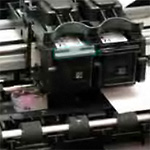 My original post on technologies of human replication, a year ago, was mostly about numbers. I estimated that a ‘fair copy’ of a human being, functionally indistinguishable from the original, could be constructed from approximately 1016 bits of information. That’s a petabyte – a lot of data by today’s standards, but not mind-boggling. One petabyte = 1024 terabytes (Tb). The going price for a 1 Tb hard drive today is $70 retail; 1024 of them would cost $71,680 (less with volume discounts). By Moore’s Law, that cost should drop to 0.7 cents by 2056. In that time-frame, other technologies required for human replication will have matured. As I argued, the business case for developing such technologies is compelling. Three business drivers – applications where the economic benefits justify the required R&D – are transportation, health, and life insurance.
My original post on technologies of human replication, a year ago, was mostly about numbers. I estimated that a ‘fair copy’ of a human being, functionally indistinguishable from the original, could be constructed from approximately 1016 bits of information. That’s a petabyte – a lot of data by today’s standards, but not mind-boggling. One petabyte = 1024 terabytes (Tb). The going price for a 1 Tb hard drive today is $70 retail; 1024 of them would cost $71,680 (less with volume discounts). By Moore’s Law, that cost should drop to 0.7 cents by 2056. In that time-frame, other technologies required for human replication will have matured. As I argued, the business case for developing such technologies is compelling. Three business drivers – applications where the economic benefits justify the required R&D – are transportation, health, and life insurance.
Some implications of the transportation and life insurance applications have already been discussed in the Phantom Self blog. Information-based teleportation –human replication as a means of transportation – is a game-changer for the transportation industry, but will not, by itself, turn society upside down. Travelling to Omaha as a stream of data will quite naturally become the usual way of doing business. The use of this technology for life insurance – restoring people from backups, after they have died – is more radical, because it changes our relationship to death. Death will be transformed from the ultimate loss to a temporary setback, like the setback called ‘death’ in a video game.
I haven’t said much about health applications. But in the medium-term future, health care looks like the biggest driver of all. Health care costs in developed nations are escalating towards fiscal crisis. According to the 2007 Commonwealth Study, the United States spends 16% of its GDP on health care – triple the percentage it spent in 1960. The trend shows no signs of abating. Average age in the developed world continues to rise, and annual health care costs increase with the age of the patient.
We need to do things better. An interesting development in health care technology, directly related to human replication, is organ printing. Continue reading “Human Replication Technology, Update 2010: Bioprinting”
 Successful replication of a mature human brain – one that we would accept as a replacement for our own, or for the brain of someone we love – must preserve almost all the connections within it. Connections embody the psychological properties that make human individuals who they are: memories, learned abilities, habits, associations, talents, and emotional responses.
Successful replication of a mature human brain – one that we would accept as a replacement for our own, or for the brain of someone we love – must preserve almost all the connections within it. Connections embody the psychological properties that make human individuals who they are: memories, learned abilities, habits, associations, talents, and emotional responses.


 All that’s needed to make a case for radical reform of the idea of self is a thought-experiment with a clear and compelling outcome. However, the world is full of people who pay no attention to thought-experiments, however revealing they may be in exposing inconsistencies in everyday ideas, because thought-experiments aren’t ‘real’. These are people from Missouri, as the saying goes, who demand to be shown. And I have nothing to show, yet.
All that’s needed to make a case for radical reform of the idea of self is a thought-experiment with a clear and compelling outcome. However, the world is full of people who pay no attention to thought-experiments, however revealing they may be in exposing inconsistencies in everyday ideas, because thought-experiments aren’t ‘real’. These are people from Missouri, as the saying goes, who demand to be shown. And I have nothing to show, yet.